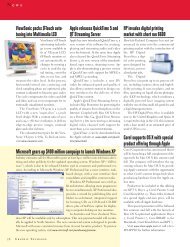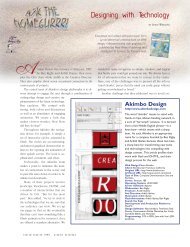by Diane Erlich - Graphic Exchange magazine
by Diane Erlich - Graphic Exchange magazine
by Diane Erlich - Graphic Exchange magazine
You also want an ePaper? Increase the reach of your titles
YUMPU automatically turns print PDFs into web optimized ePapers that Google loves.
The other thing about using newsgroups or dealingthrough the Internet is that you have to be relativelytrusting. This person went as far as to send mea photograph, his phone number and a list of otherpeople with whom he had dealt.THE BENEFITS OF BEING UNEMPLOYEDSo now I’m sitting in my apartment with a relativelynew computer and a really good idea. Somehow Ineeded to act on this, but I had no clue about how.Luckily for me, I was recently unemployed. Thatmeant that I had to go to the Human Resources DevelopmentCanada (HRDC) office to start my EmploymentInsurance (E.I.)—because that’s what youdo when you lose your job. And at this point I stillwasn’t in a position to declare my independencefrom the job market.While I was waiting to see my worker, I saw asign on the wall that read “Interested in becomingself-employed?”, and it hit me: the government hasprograms for people like me who want to run theirown businesses. True as this is, finding out aboutthem can be tricky.For instance, HRDC in conjunction with SelfEmployment Development Initiatives (SEDI) has aSelf Employment Assistance (SEA) start-up course.They help you to develop your business plan, assignyou a business advisor and, for the first year of yourbusiness, provide a small amount of income support.How do I get into the program? you might ask.Well, it’s not simple. First, I went to the HRDC orientationwhich you go to when you start E.I. In thelast five minutes, after listening to how to do a job search for awhole day, I heard them mention, “If you are thinking of self-employment,fill out this form.”Not much to go on.You don’t have to be unemployed right now to qualify for helpwith self-employment. If you have been unemployed within thelast three years, you can still apply for the program under whatthey call “reach back” assistance. However: once you’re acceptedinto one of these business development incubators, you have to“bid” for a position in the class, and at any time during theprocess they could say, “Sorry, not this time.”It takes approximately four weeks to get into the program, duringwhich time you present your idea twice and have one privatefifteen-minute interview where you get the opportunity to stateyour case. So if you’re planning to do this, you’d better be serious.I signed that piece of paper in May but didn’t get a call untilmid-July. Then I was sent to the Toronto Business DevelopmentCentre (TDBC), where I had to outbid 180 other people with“good ideas” in order to earn one of twenty-five spots available inthe program. It was nerve-racking—but I got in. And for tenweeks I sat through lectures and presentations, and eventuallycame out with my certificate and a basic business plan.BUSINESS PLAN? WHAT’S THAT?While we’re on the subject, let’s discuss the business plan. Again,if you’re like me, you probably don’t even understand why youneed one.Here’s what I learned. Your business plan is a road map ofyour business idea projected into a reality. At those odd timeswhere you stray from your business ideals, it will get you back ontrack. And if you want a loan or a line of credit for your business,you absolutely need to have one of these—or at least, this is whatI was told.But here’s what I found out. I’m sure some financial institutionswant to see a business plan, but none to which I went askedfor it. (This is not to say that they won’t, and not to undermine theimportance of having a good business plan.) What they did wantto see was a financial assessment, which I didn’t have because Iwas still in the first year of business. So in lieu of that, they askedfor my balance sheet and company registration, which I supplied.However I have not as yet been approved for either a businessloan or a line of credit.This is also when I found out about Equifax (1-800-466-7166,www.equifax.ca), where credit records are maintained. I am stilltrying to get information from these people (and I use the term“people” loosely). When dealing in business remember that younever actually get to talk to anyone any more—it’s e-mail, fax, orvoice mail, but rarely a real live breathing human being. This istrue with Equifax. When you call, they give you the “option” tospeak with someone about your credit—but before you can dothat, you have to obtain your credit history from them <strong>by</strong> mail, afteryou have provided them with photocopies of two pieces of ID.And even after that, I still wish you good luck with getting themon the phone.THE IMPORTANCE OF THOROUGH RESEARCHFor the first four months prior to registering my business (andprobably for the rest of my business life) I will be doing research.It’s that important. Before you can get started you have to knowthe answers to some fundamental questions.Like, what is it I do? What is my target market—web, print oranother design application? Who does my market affect? Will Ineed financing? Do I need equipment? How do I market myself?And even, what industry code do I fall under?I could also tell you that you need a mission statement to defineyour company, you need to get a lawyer, an accountant, a financialadvisor, and if you can, a business advisor and or a salesman.Feeling a little overwhelmed yet? I certainly was. Personally,I redefined my definition of fear when I was told to get a lawyer.But do you really need all these consultants?<strong>Graphic</strong> <strong>Exchange</strong> 11
(right) The Enterprise Toronto(www.enterprisetoronto.com)website contains some extremelyuseful information, though it’s a littledifficult to wade through. These arethe people you will go to when it’stime to REGISTER YOUR BUSINESS.Yes.Do you need them right away? Most will say yes, but I will sayno. This is your business and in the beginning you have to wearmany hats. But only you are really going to know what you do.So, having said that, what I currently maintain is the minimum.I have a business advisor, and I have an accountant. I haveseen a lawyer once, and the business advisor on several occasions.The accountant only handles my books at year end. Mindyou, I long for the day when he can handle it monthly. But forthe time being, get yourself some accounting software and learnto do your books yourself.Now let’s get down to the nitty gritty. First I needed to knowSALARY GUIDES areavailable from employmentagencies like AquentPartners (www.aquent.com)and The Creative Group(www.creativegroup.com).www.iboost.com is particularlynoteworthy for itsstand that you should neverundercharge just to getclients.(left) The NAICS or NORTH AMERICANINDUSTRIAL CLASSIFICATION SYSTEM(www.naics.com): type in “<strong>Graphic</strong>Design”, and the code pops out. You needthis code to find out the demographic ofother design services in your“neighbourhood”.(above) Strategis Canada (www.strategis.ic.gc.ca) isgreat for DEMOGRAPHICS; the “Information <strong>by</strong>Sector” area is useful just to see if there are anypapers written on the industry or any governmentdecisions you should be aware of.(left) Ever wonder what other designers use as aGUIDELINE FOR PRICING? www.brennerbooks.com.provides graph information on hourly billing rates.under what SIC code I fell (the StandardIndustrial Classification code hasnow been changed to the NAICS orNorth American Industrial ClassificationSystem—see www.naics.com). Hitthe search button, type in “<strong>Graphic</strong>Design”, and the code pops out (let’smake things a little easier—it’s541430). The reason you need thiscode is to find out the demographic ofother design services in your “neighbourhood”or the area you will be locatingyour business. The place youfind this information is StatisticsCanada (www.statcan.ca) and for themost part you really should go intotheir office (in Toronto, it’s at 25 St.Clair Avenue East). The website willgive you some good information, but Ifound talking to the nice people behindthe counter at StatsCan was farbetter and easier. Please bear in mindthat you will have to pay for most ofthe information you want fromStatsCan, even if it’s off the website.One of the most important piecesof information I obtained was that inthe city of Toronto there were 640 registeredsole proprietorships in the fieldof design and print. From this andwith a bit more research I found outthat there were only two graphic designersin the neighbourhood of mybusiness, plus three print shops, twoservice bureaus, a Kinko’s and a PrintingHouse, all within a four-kilometreradius, some within walking distance.Very useful information—but you’llsee how it works to your benefit later.LET’S DO SOME MORE RESEARCHI located a number of very useful websites for researching businessinformation and demographics.The site produced <strong>by</strong> Human Resources Development Canada(HRDC) (www.toronto-hrdc.sto.org/Includes/Rootdirectory/Common/employer/entre.shtml) is of particular interest to employersand entrepreneurs. Once inside this site you’ll find lots moreinformation on SEA and SEDI programs, as well as many linkssuch as the Canada-Ontario Business Service Centre, Starting aSmall Business in Ontario, Ontario Ministry of Labour, varioussources of financing, and an all-important link to Enterprise12 <strong>Graphic</strong> <strong>Exchange</strong>
Toronto (www.enterprisetoronto.com). (Someone really needs tospeak with Enterprise Toronto about their website; although itcontains some extremely useful information, I found this site a littledifficult to wade through. However these are the people youwill go to when it’s time to register your business.)Strategis Canada (www.strategis.ic.gc.ca) is great for demographics;in particular, the “Information <strong>by</strong> Sector” area is usefuljust to see if there are any papers written on the industry or anygovernment decisions you should be aware of. Strategis also offersan online business planner at www.strategis.ic.gc.ca/SSG/mi02687e.html. But a word of caution: although it’s really easy touse this plan, be aware that it is only a guide; some of the informationis not necessary for a startup business. But for those of uswho have never written a business plan before, it can be extremelyhelpful.Interactive Business Planner: Create your own business planon the Web (www.cbsc.org/ibp) is the one I used most because Icould store it online while I was working on it. Again, it’s a guide;in the end, I re-wrote my business plan with the help of my businessadvisor from TDBC.Small Business Quarterly Report (www.strategis.ic.gc.ca/-SSG/mi07237e.html) has great info. Did you know that the self-employedsector grew <strong>by</strong> 2.7 per cent between January 1999 and January2000? So what, right? Well, considering that you’re startingyour own business, this is certainly good information to look at.What percentage pertains to graphics, and what percentage ofthat is new businesses, and are they still around now? This site offerssome excellent industry stats and information.Canadian Intellectual Property Office (strategis.ic.gc.ca/sc_mrksv/cipo/welcome/welcom-e.html) covers copyright rules. Webster’sdefines “intellectual property” as follows: “n. a product ofthe intellect that has commercial value, including copyrightedproperty such as literary or artistic works, and ideational property,such as patents, appellations of origin, business methods, and industrialprocesses”.I had a colleague tell me recently that a potential client said,“Do the work and I will let you keep the artwork for your portfolio,”meaning in lieu of payment. I guess he didn’t realize that shewould already own it on completion, and this was no deal for her.But you have to know your rights.Strengths and Weaknesses—Overview of Canadian AdvertisingServices (strategis.ic.gc.ca/SSG/dm01195e.html) has interestingdocumentation on how advertising companies have now restructuredto meet customer needs.All said, the Strategis Canada website is definitely a good onefor research and development.Now let’s cover some links you may not necessarily think of.HOW MUCH SHOULD I CHARGE?Ever wonder what other designers or the industry in general usesas a guideline for pricing? I still wonder myself, but I did findsome useful sites to give me an idea of what to do, one of which iswww.brennerbooks.com/sampleprices.html. Very useful graph informationon hourly billing rates for Canada and the U.S. They havepricing for “graphic design” as well as “web design” and “desktoppublishing”.Another website on pricing is www.iboost.com/build/design/articles/pageview/1103.htm.This site is particularly noteworthy for itsphilosophy about pricing and the fact that you should never underchargejust to get clients. In the long run this will be self-defeating;you’re in business, and you need to act like it.Salary guides are also available from employment agencieslike The Creative Group (www.creativegroup.com) and AquentPartners (www.aquent.com).In addition to websites, I recently managed to pick up a bookthat is quite helpful (even though it is U.S.-based) called The<strong>Graphic</strong> Artist Guild Handbook: Pricing and Ethical Guidelines.Talking to other designers is another obvious way to get currentinformation on how much to charge, and the Yellow Pages isa great basic resource for finding them. They also publish a smallbook on businesses in my area, which is how I cross-referencedthe information I mentioned earlier (two graphic designers, threeprint shops, etc).I actually called the people I located through those listings(among many others) and asked them how their businesses weregoing, how long they had been around, were they always in thesame location? I needed to get a feeling for what my chances ofsurvival were. As well, it gives you a good idea of who your competitionis and what their target markets are. Most companies ordesigners will not go so far as to discuss financials, but some will.Just remember that competition is a good thing, and anyone securein their business will be more than willing to impart information.In fact, sometimes businesses we regard as competitionreally aren’t. Two of the individuals I spoke with in my sample researchhave actually swung work my way, and I have also giventhem references in their area of expertise.Another thing to consider is prior contacts with other designerswith whom you may have worked or gone to school, or eventeachers who are working in the business. If you can get them tosit down with you for five minutes, they may give you more up-todateinformation than you could get anywhere else. And it’s definitelyless time-consuming than the Internet.TRADE AND PROFESSIONAL ASSOCIATIONSOne of the recommendations of the Toronto Business DevelopmentCentre was to find and contact “associations” in your industry.I found this to be more difficult than it sounds but excellentadvice nonetheless. Although many of the links contained hereare American associations, don’t discount them. In some cases Ifound them to be more helpful than our local associations.Since the demise of Toronto Webgrrls, my only associationmembership is with DigitalEve (www.digitaleve.com, or for the<strong>Graphic</strong> <strong>Exchange</strong> 13
Toronto chapter www.digitaleve.com/toronto/index.php). On morethan one occasion this group of women has been extremely helpfulin getting me networked with other people and organizations,as well as allowing me free promotion through their listings.The Designers Resource (www.gain.org/servlet/gateway/business_solutions/links/associations.html)is also an excellent site, and agreat resource for locating trade and professional associations.Much of the information on this site is American but it also haslinks to the Canadian Printing Industry Association (CPIA) andthe Canadian Pulp & Paper Association (CPPA).Useful? Absolutely. If anyone has their finger on the pulse ofthe graphic arts industry, it’s these people. Questions like, what (ifany) is the decline in the paper industry with regard to print production?This definitely trickles down and affects the designer. Ifyou’re a print specialist, and print usage looks like it might beheading down, you may want to consider switching your target toweb design, or even e-books. On this note, check out Print CanadaAssociation’s page (www.printcan.com/assoc.htm).Also on the Web you’ll find the progress report from the steeringcommittee of the Canadian Printing and <strong>Graphic</strong>s Industry(1996) (www.on.ec.gc.ca/ glimr/data/first-printing-rep/begin.html).Why in the world would information from 1996 be relevant today?You will come across this problem often, particularly whendealing with Statistics Canada or almost any other governmentoperatedstatistical information source. The rule of thumb is thatif it’s about three years old, it’s probably the most recent informationavailable.According to its website, The <strong>Graphic</strong> Design PublishingCenter News (www.graphic-design.com/news/index.html) is thelongest running Web portal for design, typography, graphics, illustration,writing, printing, publishing, advertising, signs, displaysand information for graphic communicators! As far as I am concerned,that’s a relatively accurate description of what they do. Itis U.S.-based but I am including it here just for comparison. Theydo have discussions on pricing (e.g. how much to charge forbuilding one or two graphics for existing websites, or for fixingother people’s mistakes). In general it is a discussion board for awide range of topics, and the topics change constantly.Got a library card? If not, get one. This is probably the best resourcefor finding periodicals—and guess what? You can do itfrom your own computer via the Internet and e-mail them backto yourself. All you need to do is use your library card—checkvrl.tpl.toronto.on.ca.GOT THE INFO—NOW WHAT DO I DO WITH IT?Finding the information is only a small part of the battle—and,believe me, finding anything pertaining to legal or government issueson the “graphic design industry” isn’t easy. Often what Ifound were documents or periodicals. But coupled with the fewhard facts I could find, it began to slowly unravel.Earlier I mentioned that there were at the time 640 registeredsole proprietorship “design services” in the area. But how did Ifind out there were only two graphic designers in my area? I goton the Internet and looked up any page that carried phone listingsfor services online, starting with one that I am listed with,www.yellow.ca (Canadian Yellow Business Directory Pages). It willlet you list yourself for free (there’s that wonderful word again)and if you want, for a modest fee it can bring you to the top of thelistings as well as provide a link to your home page.If you go to the Yellow Pages home page, you will find an interestingfact: graphic designers are listed third in the “Top 10Classifications” list. I decided this could be a good place to checkout the competition. I clicked on “<strong>Graphic</strong> Designers” and askedfor the listings for Toronto, Ontario—654 popped up. So now Iknew that my research from StatsCan was only partially correct.What does this mean?it means that not everyone registers themselves as a business.<strong>Graphic</strong> designers don’t have to register themselves, since as a designeryou are the business, and thus you can just use your name.So, if StatsCan says there are 640 businesses registered and yet Ihave already found 654 in one online listing, how many other designersor companies offering design services are out there?Please keep in mind you could be doing research for a verylong time. At some point you have to say, “Enough!” You couldeasily spend years and never get your business off the ground.In the past year I have put aside two days out of every monthto check my research and make sure that I am current with whateveris out there. And that’s really all you can do—that is, untilyour business grows big enough to let you hire a Research andDevelopment specialist once a year who will do it for you.OPEN FOR BUSINESS AT LASTI will never forget November 1st, 2000, the day I officially registeredmy business.I walked away from the registrar (Enterprise Toronto) with afellow entrepreneur, my arms full of paperwork.Did I mention that part never ends too? As I looked at the paperwork,all I could think about was, “Was this a good idea or abad idea?”It is not entirely necessary to register a business name. Registeringthe name actually cost me $60, but if I had wanted to Icould have easily just used my own name and then not registeredat all. For me, the main reasons for registering were that I wantedto have a separate bank account for the company—and I wantedto have the “image” of a larger company.Although today many people are used to dealing with small“home-based” companies, there are still corporations that don’twant to have contracts with individuals. If you can make them believethat they are dealing with a “professional” organization thenit makes it easier to seal the deal. I can’t say this enough.You are the business—even if one of your cats is lying on yourmonitor while you work, or it’s a sunny day and the pool demands14 <strong>Graphic</strong> <strong>Exchange</strong>
your attention. Your client doesn’t needto know that.I also registered for a PST number.Nothing tells suppliers you are seriousabout your business as effectively as whenthey bill you, and you say you are PST-exemptand give them your number.(right) www.yellow.ca (CanadianYellow Business Directory Pages)will let you LIST YOURSELF forfree. For a modest fee it can bringyou to the top of the listings aswell as provide a link to yourhome page.(above) The Designers Resource (www.gain.org) isgreat for locating TRADE and PROFESSIONALASSOCIATIONS. Much of the information isAmerican but it also has links to the CanadianPrinting Industry Association (CPIA) and theCanadian Pulp & Paper Association (CPPA).(right) The <strong>Graphic</strong> Design Publishing Center News(www.graphic-design.com) is a U.S.-basedDISCUSSION BOARD for a wide range of topics,including discussions on pricing.DigitalEve (www.digitaleve.com):this group of women has beenextremely helpful in getting meNETWORKED with other peopleand organizations, as well asallowing me free promotionthrough their listings.SO…HOW’S IT GOING?The last year has had its share of “MaybeI should just find a job!”, and “How doesthis accounting software work exactly?”But I have managed to do some clientwork, although mostly I have been teaching.It started in December with a phonecall—was I able to teach a corporate classin PowerPoint for Mac? From there, I wasasked back to teach Office 2001 to thesame group.Still doing research. Still going afterclients. In January I had a panic attackthat I wouldn’t survive, so I took a parttimejob at a bookstore—which ended upbeing a great idea. As it turned out, itwasn’t about the money, but the networking.Not to mention that sitting on mybutt in front of a computer was not doingme any good physically.While I’m on the subject, eventhough it is important to be available forpotential clients, and even though you doneed to spend a large part of your day “inthe office”, try to spend an equal amountof time doing something else for yourself. The job at the bookstoreturned out to be not a defeat for my business but a greatsource of information, people contacts, and exercise.The funniest thing that happened in my panic to get some incomewas that I actually got what has turned into one of the bestthings that has happened to me yet—a part-time teaching contractat a local college. One semester has turned into another halfsemester, which in turn turned into night school, and in SeptemberI hope to be teaching three classes a week plus night school.I still have my share of clients. I haven’t made my first millionquite yet.But if I don’t, it doesn’t mean I failed. One of the best thingsin my “good idea” is actually working out fine: my business planis doing exactly what as it should, guiding me through the darknessto the light of a long overdue vacation, my first in five years.At times it was very hard to stay focused. The term I like to useis that “I am easily distracted <strong>by</strong> shiny things.” Although it’s a funnystatement, it’s very true. It’s easy to stray into surfing the Internetwhile doing research and land at what looks like an interestingsite—and three hours later you’ve done nothing. Then there’sthe element of friends and family who will call you during theday to chat. For some reason when I was working for someoneelse that wasn’t a problem, but now it’s a big deal.But no one is handing me deadlines at ten minutes to five andsaying I have to present in the morning. I can set up my own accountswith the printers I like and not the ones who happen to bedownstairs. And when I go on vacation, I can give myself a monthoff—or even take my laptop with me, in case I get seized <strong>by</strong> feelingsof insecurity.So here I am, two years later, coming up on the close of myfirst year end in business, and I’m still a self-employed free agent.And you know something? Just typing that still sends shiversdown my spine.<strong>Diane</strong> <strong>Erlich</strong> is president of Orchid <strong>Graphic</strong>s, a Toronto-based design firm.She may be contacted at orchidgraphics@sympatico.ca.<strong>Graphic</strong> <strong>Exchange</strong> 15
















